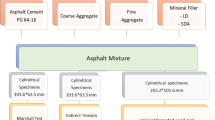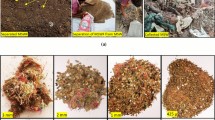Abstract
The most economical, environmental, and friendly method for recycling gangue is filling mining with cemented waste rock backfill (CWRB), which solves the environmental problems caused by gangue discharge and reduces the mining damages. Evaluating the mesoscopic structure of CWRB is of great significance for maximizing the utilization of gangue recycling and improving the economic benefits of filling mining. This paper constructed the particle flow model of cemented waste rock backfill (CWRB) considering particle size distribution (PSD) of aggregates and hydration of cementing material to investigate the effect of the PSD of aggregates on its mesoscopic structural evolution. The strain energy, crack, force chain, and particle fragment of CWRB during the whole loading were discussed. The binary processing and calculation on the crack image were performed to analyze the fractal dimension of crack distribution by compiling program. The influencing mechanism of the PSD of aggregates on the strength of CWRB is revealed from the mesoscopic levels of crack evolution, force chain structure, and particle fragment. The results show that the strain energy increases firstly and then decreases with the PSD fractal dimension, while the crack number decreases firstly and then increases with that. The cracks with less number and more uniform distribution present the smaller fractal dimension, CWRB with a low fractal dimension of crack distribution has higher strength, the fractal dimension of crack distribution exhibits a correlation with the PSD of aggregates. CWRBs with the PSD fractal dimensions of 2.4–2.6 have the largest strain energy and the smallest crack number, performing the superior structural evolution during loading. This study presents the huge potential of optimizing PSD in CWRB application from a new perspective, it is of great significance for strengthening the internal structure of CWRB and reducing engineering cost.













Similar content being viewed by others
Abbreviations
- CWRB:
-
Cemented waste rock backfill
- d i :
-
Size of aggregate particles
- d max :
-
Maximum size of aggregate particles
- D :
-
PSD fractal dimension
- D c :
-
Fractal dimension of crack distribution
- M i :
-
Mass of aggregate particles in size below or equal to d, \( {M}_i={M}_{\mathrm{t}}{\left(\frac{d_i}{d_{\mathrm{max}}}\right)}^{3\hbox{-} D} \)
- M t :
-
Total mass of aggregate particles
- N i :
-
Crack number
- N b :
-
Box count
- N c :
-
Cumulative crack number
- N t :
-
Total boxes
- P i :
-
Mass ratio of aggregate particles, \( {P}_i=\frac{M_i}{M_{\mathrm{t}}}={\left(\frac{d_i}{d_{\mathrm{max}}}\right)}^{3-D} \)
- PSD:
-
Particle size distribution
- U :
-
Strain energy
- SEM:
-
Scanning electron microscope
- UCS:
-
Uniaxial compressive strength
- XRD:
-
X-ray diffraction
- σ 1 :
-
Axial stress
- σ 1c :
-
Peak stress, σ1c = UCS
- ε :
-
Axial strain
- ε 1c :
-
Peak strain
References
ASTM Standard C192/C192M-13a (2013) Standard practice for making and curing concrete test specimens in the lab. Annual Book of ASTM Standards, West Conshohocken. Available online: https://doi.org/10.1520/C0192_C0192M-13A
ASTM Standard C39/C39M-15a (2015) Standard test method for compressive strength of cylindrical concrete specimens. Annual Book of ASTM Standards, West Conshohocken. Available online: https://doi.org/10.1520/C0039_C0039M-15A
Assi LN, Deaver EE, Ziehl P (2018) Effect of source and particle size distribution on the mechanical and microstructural properties of fly ash-based geopolymer concrete. Constr Build Mater 167:372–380
Belem T, Benzaazoua M (2008) Design and application of underground mine paste backfill technology. Geotech Geol Eng 26(2):175–175
Benzaazoua M, Belem T, Bussière B (2002) Chemical factors that influence the performance of mine sulphidic paste backfill. Cem Concr Res 32(7):1133–1144
Bian ZF, Miao XX, Lei SG, Chen SE, Wang WF, Struthers S (2012) The challenges of reusing mining and mineral-processing wastes. Science. 337(6095):702–703
Cao S, Song WD, Yilmaz E (2018) Influence of structural factors on uniaxial compressive strength of cemented tailings backfill. Constr Build Mater 174:190–201
Cao S, Yilmaz E, Song WD (2019) Fiber type effect on strength, toughness and microstructure of early age cemented tailings backfill. Constr Build Mater 223:44–54
Cao S, Xue GL, Yilmaz E, Yin ZY, Yang FD (2021) Utilizing concrete pillars as an environmental mining practice in underground mines. J Clean Prod 278:123433
Chen QS, Zhang QL, Qi CC, Fourie A, Xiao CC (2018) Recycling phosphogypsum and construction demolition waste for cemented paste backfill and its environmental impact. J Clean Prod 186:418–429
Cihangir F, Ercikdi B, Kesimal A, Turan A, Deveci H (2012) Utilisation of alkali-activated blast furnace slag in paste backfill of high-sulphide mill tailings: effect of binder type and dosage. Miner Eng 30(4):33–43
Cui L, Fall M (2016) Mechanical and thermal properties of cemented tailings materials at early ages: influence of initial temperature, curing stress and drainage conditions. Constr Build Mater 125:553–563
Deng DQ, Liu L, Yao ZL, Song K, Lao DZ (2017) A practice of ultra-fine tailings disposal as filling material in a gold mine. J Environ Manag 196:100–109
Ercikdi B, Cihangir F, Kesimal A, Deveci H, Alp İ (2009a) Utilization of industrial waste products as pozzolanic material in cemented paste backfill of high sulphide mill tailings. J Hazard Mater 168(2–3):848–856
Ercikdi B, Kesimal A, Cihangir F, Deveci H, Alp İ (2009b) Cemented paste backfill of sulphide-rich tailings: importance of binder type and dosage. Cement Concrete Comp 31(4):268–274
Ercikdi B, Yilmaz T, Külekci G (2014) Strength and ultrasonic properties of cemented paste backfill. Ultrasonics. 54(1):195–204
Fall M, Benzaazoua M, Ouellet S (2005) Experimental characterization of the influence of tailings fineness and density on the quality of cemented paste backfill. Miner Eng 18(1):41–44
Huang YH, Yang SQ, Tian WL (2019) Crack coalescence behavior of sandstone specimen containing two pre-existing flaws under different confining pressures. Theor Appl Fract Mec 99:118–130
Jiang HQ, Yi HS, Yilmaz E, Liu SW, Qiu JP (2020) Ultrasonic evaluation of strength properties of cemented paste backfill: effects of mineral admixture and curing temperature. Ultrasonics. 100(1):105983
Ke X, Zhou X, Wang XS, Wang T, Hou HB, Zhou M (2016) Effect of tailings fineness on the pore structure development of cemented paste backfill. Constr Build Mater 126:345–350
Li M, Zhang JX, Li AL, Zhou N (2020) Reutilisation of coal gangue and fly ash as underground backfill materials for surface subsidence control. J Clean Prod 254:120113
Li XB, Du J, Gao L, He SY, He SY, Gan L, Sun C, Shi Y (2017) Immobilization of phosphogypsum for cemented paste backfill and its environmental effect. J Clean Prod 156:137–146
Liu B, Gao YT, Jin AB, Xue W (2020) Influence of water loss on mechanical properties of superfine tailing-blast-furnace slag backfill. Constr Build Mater 246(6):118482
Liu QS, Liu DF, Tian YC, Liu XY (2017) Numerical simulation of stress-strain behaviour of cemented paste backfill in triaxial compression. Eng Geol 231:165–175
Liu RC, Li B, Jiang YJ, Yu LY (2018) A numerical approach for assessing effects of shear on equivalent permeability and nonlinear flow characteristics of 2-D fracture networks. Adv Water Resour 111:289–300
Ma D, Duan HY, Liu JF, Li XB, Zhou ZL (2019a) The role of gangue on the mitigation of mining-induced hazards and environmental pollution: an experimental investigation. Sci Total Environ 664:636–448
Ma D, Duan HY, Li XB, Li ZH, Zhou ZL, Li TB (2019b) Effects of seepage-induced erosion on nonlinear hydraulic properties of broken red sandstones. Tunn Under Sp Tech 91:102993
Ma D, Duan HY, Liu WT, Ma XT, Tao M (2020) Water-sediment two-phase flow inrush hazard in rock fractures of overburden strata during coal mining. Mine Water Environ 39:308–319
Ma D, Zhang JX, Duan HY, Huang YL, Li M, Sun Q, Zhou N (2021) Reutilization of gangue wastes in underground backfilling mining: Overburden aquifer protection. Chemosphere 264:128400
Sari D, Pasamehmetoglu AG (2005) The effects of gradation and admixture on the pumice lightweight aggregate concrete. Cem Concr Res 35(5):936–942
Sevim Ö, Demir İ (2019) Physical and permeability properties of cementitious mortars having fly ash with optimized particle size distribution. Cement Concrete Comp 96:266–273
Shi XS, Zhao J (2020) Practical estimation of compression behavior of clayey/silty sands using equivalent void-ratio concept. J Geotech Geoenviron 146:04020046
Sun Q, Tian S, Sun QW, Li B, Cai C, Xia YJ, Wei X, Mu QW (2019) Preparation and microstructure of fly ash geopolymer paste backfill material. J Clean Prod 225:376–390
Tian WL, Yang SQ, Huang YH, Hu B (2020) Mechanical behavior of granite with different grain sizes after high-temperature treatment by particle flow simulation. Rock Mech Rock Eng 53:1791–1807
Wu D, Zhang YL, Liu YC (2016) Mechanical performance and ultrasonic properties of cemented gangue backfill with admixture of fly ash. Ultrasonics. 64:89–96
Wu JY, Feng MM, Mao XB, Xu JM, Zhang WL, Ni XY, Han GS (2018) Particle size distribution of aggregate effects on mechanical and structural properties of cemented rockfill: experiments and modeling. Constr Build Mater 193:295–311
Wu JY, Feng MM, Ni XY, Mao XB, Chen ZQ, Han GS (2019) Aggregate gradation effects on dilatancy behavior and acoustic characteristic of cemented rockfill. Ultrasonics. 92(2):79–92
Wu JY, Jing HW, Yin Q, Meng B, Han GS (2020) Strength and ultrasonic properties of cemented waste rock backfill considering confining pressure, dosage and particle size effects. Constr Build Mater 242:118132
Yilmaz E, Belem T, Bussière B, Mbonimpa M, Benzaazoua M (2015) Curing time effect on consolidation behaviour of cemented paste backfill containing different cement types and contents. Constr Build Mater 75(75):99–111
Yilmaz E (2018) Stope depth effect on field behaviour and performance of cemented paste backfills. Int J Min Reclam Environ 32(4):273–296
Zuo JP, Hong ZJ, Xiong ZQ, Wang C, Song HQ (2018) Influence of different W/C on the performances and hydration progress of dual liquid high water backfilling material. Constr Build Mater 190:910–917
Availability of data and materials
The datasets used and/or analyzed during the current study are available from the corresponding author on reasonable request.
Funding
This work was supported by the National Natural Science Foundation of China (52004272, 51734009, 51904290), Natural Science Foundation of Jiangsu Province, China (BK20200660, BK20180663), Engineering Research Center of Development and Management for Low to Ultra-Low Permeability Oil & Gas Reservoirs in West China, Ministry of Education, Xi’an Shiyou University (KFJJ-XB-2020-6), China Postdoctoral Science Foundation (2019M661987).
Author information
Authors and Affiliations
Contributions
J.Y. Wu and Q. Yin conceived and designed the experiments. J.Y. Wu, Q. Yin, Y. Gao, and B. Meng performed the experiments. J.Y. Wu, Q. Yin, and H.W. Jing analyzed the data. J.Y. Wu, Q. Yin, and H.W. Jing wrote the paper.
Corresponding authors
Ethics declarations
Conflict of interest
The authors declare that they have no conflict of interest.
Ethical approval
Not applicable.
Consent to participate
Not applicable.
Consent to publish
Not applicable.
Additional information
Responsible editor: Philippe Garrigues
Publisher’s note
Springer Nature remains neutral with regard to jurisdictional claims in published maps and institutional affiliations.
Rights and permissions
About this article
Cite this article
Wu, J., Yin, Q., Gao, Y. et al. Particle size distribution of aggregates effects on mesoscopic structural evolution of cemented waste rock backfill. Environ Sci Pollut Res 28, 16589–16601 (2021). https://doi.org/10.1007/s11356-020-11779-9
Received:
Accepted:
Published:
Issue Date:
DOI: https://doi.org/10.1007/s11356-020-11779-9




